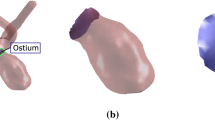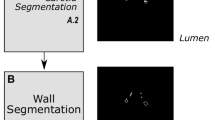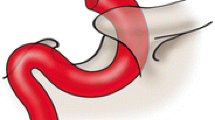Abstract
Purpose
The development of intracranial internal carotid artery (ICA) stenoses may be associated with the morphology of the siphon. The aim is to quantitatively characterize the geometry of ICA, and develop a classifier of the ICA shape in relation to the location and incidence of stenoses.
Methods
The ICA geometry from 74 subjects was analyzed by means of image-based computational techniques. The siphon was split into two bends, and was described in terms of curvature radius, radius of vessel, angle of bending, and length. Differences of geometry between ICA classes were assessed in control group, consisted of 30 subjects without stenoses. In stenosed group, the association between the ICA classes and the incidence of stenoses were investigated and validated by hemodynamic simulation.
Results
The curvature radius and angle of the posterior bend were significantly different between ICA classes, as well as the angle between the two bends. An innovative classifier was developed with the three geometric parameters. The ICA classification was found associated with the incidence of stenoses at the siphon.
Conclusions
Geometric factors relative to the ICA were correlated with the location and incidence of stenoses at the siphon. The present work has potential implications in the quest for hemodynamic factors contributing to the initiation and progression of intracranial ICA stenoses.







Similar content being viewed by others
References
Bogunovic H, Pozo JM, Cardenes R et al (2012) Automated landmarking and geometric characterization of the carotid siphon. Med Image Anal 16:889–903
Boskamp T, Rinch D, Link F et al (2004) New vessel analysis tool for morphometric quantification and visualization of vessels in CT and MR imaging data sets. Radiographics 24:287–297
Craig DR, Meguro K, Watridge C et al (1982) Intracranial internal carotid artery stenosis. Stroke 13:825–828
Flaherty JT, Ferrans VJ, Pierce JE et al (1972) Localizing factors in experimental atherosclerosis. In: Likoff W, Segal BL, Insull W Jr (eds) Atherosclerosis and coronary heart disease. Grune and Stratton, New York, pp 40–84
Flaherty JT, Pierce JE, Ferrans VJ et al (1972) Endothelial nuclear patterns in the canine arterial tree with particular reference to hemodynamic events. Circ Res 30:23–33
Friedman MH (2002) Variability of 3D arterial geometry and dynamics, and its pathologic implications. Biorheology 39:513–517
Kim JS, Caplan LR, Wong KSL (2008) Intracranial atherosclerosis. Wiley, London
Krayenbuehi H, Yasargil M, Huber P (1982) Cerebral angiography. Thieme, New York
Lee KE, Parker KH, Caro CG et al (2006) The spectral/hp element modeling of steady flow in non-planar double bends. Int J Numer Meth Fluids 57:519–529
Lee SE, Lee SW, Fischer PF et al (2008) Direct numerical simulation of transitional flow in a stenosed carotid bifurcation. J Biomech 41:2551–2561
Lee SW, Antiga L, Spence JD et al (2008) Geometry of the carotid bifurcation predicts its exposure to disturbed flow. Stroke 39:2341–2347
Lin WC, Liang CC, Chen CT (1988) Dynamic elastic interpolation for 3-D medical image reconstruction from serial cross sections. IEEE Trans Med Imaging 7:225–232
Lorensen WE, Cline HE (1987) Marching cubes: a high resolution 3D surface construction algorithm. Comput Graph 21:163–169
Malek AM, Apler SL, Izumo S (1999) Hemodynamic shear stress and its role in atherosclerosis. JAMA 282:2035–2042
Marzewski DJ, Furlan AJ, Louis PS et al (1982) Intracranial internal carotid artery stenosis: longterm prognosis. Stroke 13:821–824
Meng S, Costa LF, Geyer SH et al (2008) Three-dimensional description and mathematical characterization of the parasellar internal carotid artery in human infants. J Anat 212:636–644
Meng S, Geyer SH, Costa LF et al (2008) Objective characterization of the course of the parasellar internal carotid artery using mathematical tools. Surg Radiol Anat 30:519–526
Muller HR, Brunholzl C, Radu EW et al (1991) Sex and side differences of cerebral arterial caliber. Neuroradiology 33:212–216
Passerini T, Sangalli LM, Vantini S et al (2012) An integrated statistical investigation of internal carotid arteries of patients affected by cerebral aneurysms. Cardiovasc Eng Tech 3:26–40
Piccinelli M, Bacigaluppi S, Boccardi E et al (2011) Geometry of the internal carotid artery and recurrent patterns in location, orientation, and rupture status of lateral aneurysms: an image-based computational study. Neurosurgery 68:1270–1285
Piccinelli M, Hoi Y, Steinman D et al (2012) Automatic neck plane detection and 3D geometric characterization of aneurismal sacs. Ann Biomed Eng 3:26–40
Provenzale JM (1995) Dissection of the internal carotid and vertebral arteries: imaging features. Am J Roentgenol 165:1099–1104
Qiao AK, Guo XL, Wu SG et al (2004) Numerical study of nonlinear pulsatile flow in S-shaped curved arteries. Med Eng Phys 26:545–552
Raghavan ML, Ma B, Harbaugh RE (2005) Quantified aneurysm shape and rupture risk. J Neurosurg 102:355–362
Sakata N, Takebayashi S (1988) Localization of atherosclerotic lesions in the curving sites of human internal carotid arteries. Biorheology 25:567–578
Sangalli LM, Secchi P, Vantini S et al (2009) A case study in exploratory functional data analysis: Geometrical features of the internal carotid artery. J Am Stat Assoc 104:37–48
Sangalli LM, Pi Secchi, Vantini S et al (2010) K-mean alignment for curve clustering. Comput Stat Data Anal 54:1219–1233
Schubert T, Santini F, Stalder AF et al (2011) Dampening of blood-flow pulsatility along the carotid siphon: does form follow function? AJNR Am J Neuroradiol 32:1107–1112
Van Gijin J, Kerr RS, Rinkel GJ (2007) Subarachnoid haemorrhage. Lancet 369:306–318
Zhang C, Xie S, Li S et al (2012) Flow patterns and wall shear stress distribution in human internal carotid arteries: the geometric effect on the risk for stenoses. J Biomech 45:83–89
Acknowledgments
This study was supported by the National Natural Science Foundation of China (No. 61190123, 10925208).
Conflict of interest
This study has no conflict of interest to report.
Author information
Authors and Affiliations
Corresponding authors
Rights and permissions
About this article
Cite this article
Zhang, C., Pu, F., Li, S. et al. Geometric classification of the carotid siphon: association between geometry and stenoses. Surg Radiol Anat 35, 385–394 (2013). https://doi.org/10.1007/s00276-012-1042-8
Received:
Accepted:
Published:
Issue Date:
DOI: https://doi.org/10.1007/s00276-012-1042-8




